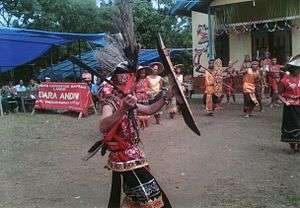Kendayan
|
A Kendayan dancer in traditional attire performs at a church dedication service in Landak Regency, West Kalimantan, Indonesia. | |
| Total population | |
|---|---|
| 357,000[1] | |
| Regions with significant populations | |
| West Kalimantan, Indonesia | |
| Languages | |
| Kendayan language, Ahe language, Nana language, Damea or Jare language, Ape language | |
| Religion | |
| Folk religion (predominantly), Christianity | |
| Related ethnic groups | |
| Selako, Dayak people |
The Kendayan (also known as Dayak Kendayan or Kanayatn) people are an ethnic group native to Kalimantan, Indonesia. Kanayatn grouped into categories clump Land Dayak-Klemantan by HJ Mallinckrodt (1928). But according to C.H. Duman (1929), it is part of the Kanayatn Dayak Ot Danum Clump-Maanyan-Ngaju. However, research by W.Stohr (1959) disagrees with CH Duman because when viewed from the region, language, as well as customary law, Dayak Kanayatn does not appear to be associated with clump's group Ot-Danum-Maanyan-Ngaju, but more so with the group Land Dayak- Klemantan. Even giving Landak District names based on the majority Dayak community Kanayatn which is part of the clump Land Dayak (Land Dayak or Land Djak in Dutch spelling). Kanayatn and Salako, it is in fact one tribe. Salako people assume that "Kanayatn" is not even the real name of this tribe.
Language
Kanayatn languages encompasses languages such as Baahe, Banana' language, Badamea or Jare language (more like Selako language), and Bangape. Sociology-linguistically (the line connecting the similarities and differences that are cognate vocabulary) it is very difficult to specify the language repertoire because the language used is loaded with various dialects and patois pronunciation.
Many Dayak Kanayatn of the current generation do not understand the languages spoken by the older generation. Today's communication adopted many Indonesian vocabulary and then "on-the-Dayak". Example is: Ahe native language: Lea, Indonesian: seperti, Ahe language now: saparati. The language, used now by the younger generation, is easy to understand because it is similar to Indonesian or Malay.
Weapons
The Kanayatn Tribe uses Tangkitn as primary weapon for head hunting in the past. In Salako language, Tangkitn is also referred to as Parang Pandat. The Kanayatn tribe also uses shields to deflect attacks from the enemy's sword. According to Kanayatn people in Mempawah (sompak-mempawah hulu-menjalin-toho-sadaniang), there are two types of shields in Kanayatn culture: Gunapm and Jabakng. However, according to Kanayatn people in Landak (including sei Ambawang & Kuala Mandor), there is just one type of shield namely Gunapm.
Religion
The original religion of the Kanayatn people is not the Kaharingan like other Dayak people. Kanayatn Dayak's indigenous religion is inseparable from their customs (Adat). It can even be said their customs assert their religious identity. In daily practice, Kanayatn Dayak people never mention religion as their normative, but Adat (custom). This religious system is not a Hindu Kaharingan system as it is known by the general public.
Kanayatn people refer to God as Jubata.[2] Jubata is said to have passed down indigenous customs to the ancestors of Dayak Kanayatn located in Bukit Bawakng (now entering the district Bengkayang). In expressing belief in Jubata, they have a place of worship called "panyugu" or "padagi" (kadiaman).[3] It is also important for the panyangahatn priest to become a liaison between man and God (Jubata).[4]
Today, most Dayak Kanayatn have embraced Christianity and a few others, Islam. Kenanyatn people who have embraced another religion can no longer consider themselves as Dayak Kanayatn once they have abandoned their customary practices. Similarly, Kanayatn people who have embraced Islam will no longer regard themselves as Dayak, but as Malay people or Orang laut.
Folk songs
- Kao Ada Ka Atiku[5]
- Tagila-Gila[6]
- Taringat Ka' Kao[7]
- Cintaku Ka' Ia[8]
- Pasatn Urakng Tuha[9]
- Batamu[10]
- Babalas Pantun[11]
- Gawe Panganten[12]
- Nunggu Kao Pulakng[13]
- Bakanalatn[14]
- Lupa Ka' Janji[15]
- Buah Atiku[16]
- Sayang[17]
- Bapantun[18]
- Kambang Bepanggel[19]
- Sayangku Ka Kao[20]
- Ka'o Ningalat'n[21]
- Malam Batabur Bintakng[22]
- Niat Idup Badua[23]
- 4 Tingkakok Nimang Padi[24]
References
- ↑ "Dayak Kendayan in Indonesia". Joshua Project. Retrieved 2014-11-07.
- ↑ Mudiyono (1990). Sistem Pengendalian Sosial Tradisional Desa Tiang Tanjung, Propinsi Kalimantan Barat. Departemen Pendidikan dan Kebudayaan, Direktorat Jenderal Kebudayaan, Direktorat Sejarah dan Nilai Tradisional, Proyek Inventarisasi dan Pembinaan Nilai-Nilai Budaya. OCLC 555243328.
- ↑ Hermann Vierling (1990). Hermeneutik, Stammesreligion, Evangelium: interkulturelle Kommunikation bei den Kendayan. Gütersloher Verlagshaus G. Mohn. ISBN 3-5790-0243-0.
- ↑ Rohany (1990). Peralatan Produksi Tradisional Dan Perkembangannya Daerah Kalimantan Barat. Departemen Pendidikan dan Kebudayaan, Kanwil Depdikbud Propinsi Kalimantan Barat, Proyek Inventarisasi dan Pembinaan Nilai-Nilai Budaya Kalimantan Barat. OCLC 551341177.
- ↑ "Kao ada ka atiku". YouTube. Retrieved 2014-11-07.
- ↑ "Tagila-gila". YouTube. Retrieved 2014-11-07.
- ↑ "TARINGAT KA' KAO". YouTube. Retrieved 2014-11-07.
- ↑ "CINTAKU KA' IA". YouTube. Retrieved 2014-11-07.
- ↑ "PASATN URAKNG TUHA". YouTube. Retrieved 2014-11-07.
- ↑ "BATAMU". YouTube. Retrieved 2014-11-07.
- ↑ "BABALAS PANTUN". YouTube. Retrieved 2014-11-07.
- ↑ "GAWE PANGANTEN". YouTube. Retrieved 2014-11-07.
- ↑ "NUNGGU KAO PULAKNG". YouTube. Retrieved 2014-11-07.
- ↑ "Bakanalatn". YouTube. Retrieved 2014-11-07.
- ↑ "LUPA KA' JANJI". YouTube. Retrieved 2014-11-07.
- ↑ "BUAH ATIKU". YouTube. Retrieved 2014-11-07.
- ↑ "SAYANG". YouTube. Retrieved 2014-11-07.
- ↑ "BAPANTUN". YouTube. Retrieved 2014-11-07.
- ↑ "kambang bepanggel". YouTube. Retrieved 2014-11-07.
- ↑ "Sayangku Ka Kao". YouTube. Retrieved 2014-11-07.
- ↑ "Ka'o Ningalat'n". YouTube. Retrieved 2014-11-07.
- ↑ "Malam Batabur Bintakng". YouTube. Retrieved 2014-11-07.
- ↑ "Niat Idup Badua". YouTube. Retrieved 2014-11-07.
- ↑ "4 Tingkakok Nimang Padi". YouTube. Retrieved 2014-11-07.
